Key takeaways:
- Sustainable investing aligns financial goals with personal values, prioritizing environmental and social impacts alongside returns.
- Key strategies include diversifying investments in green technologies and conducting thorough research on companies’ ESG practices.
- Utilizing tools for measuring sustainability, such as MSCI ESG Ratings and green certification databases, enhances informed investment decisions.
- Engagement with companies and community-building supports transparency and reinforces commitment to sustainable investing practices.
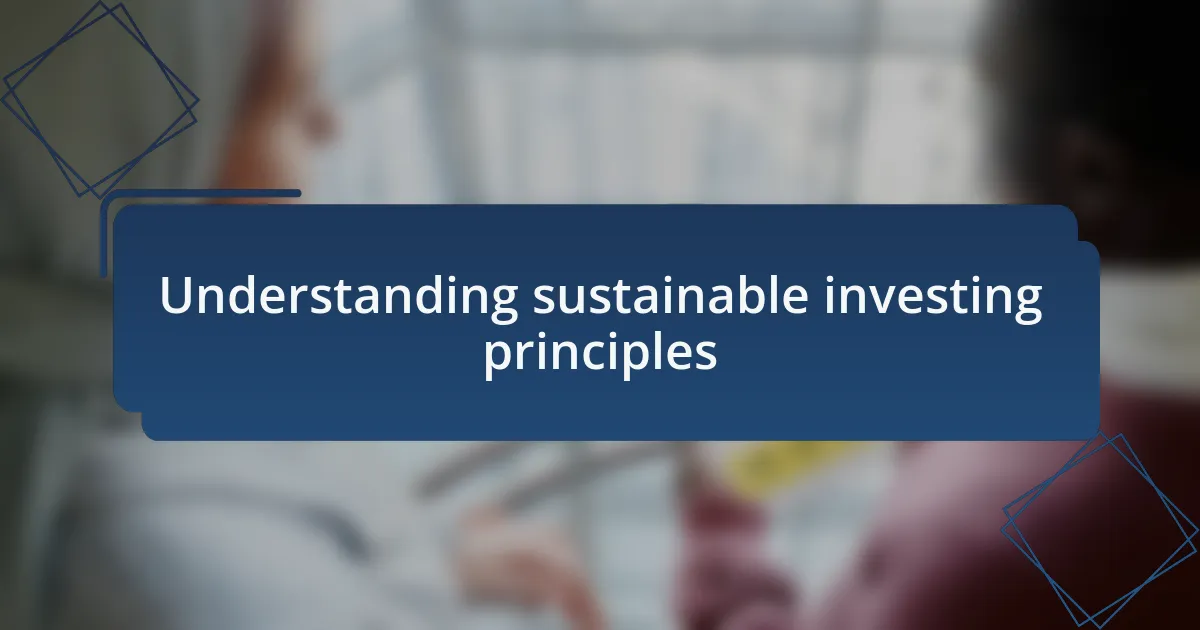
Understanding sustainable investing principles
Sustainable investing is fundamentally about aligning your financial goals with your values. When I first ventured into this space, I was surprised to discover how my portfolio could reflect my commitment to environmental and social issues. Isn’t it empowering to know that your investments can support companies that prioritize sustainability?
One of the core principles of sustainable investing is the integration of environmental, social, and governance (ESG) criteria. I remember the moment I realized that I could assess not just a company’s financial stability but also its ethical footprint. It changed the way I viewed investing—suddenly, I wasn’t just chasing returns, but also considering the long-term impact of my choices on the planet and society.
Another important aspect is the emphasis on transparency and accountability. I often ask myself: How can I truly trust a company’s sustainability claims? I’ve learned to look for rigorous third-party evaluations and certifications, which provide that extra layer of assurance. It’s this diligence that not only shapes my investment strategy but also allows me to feel genuinely connected to the outcomes of my financial decisions.
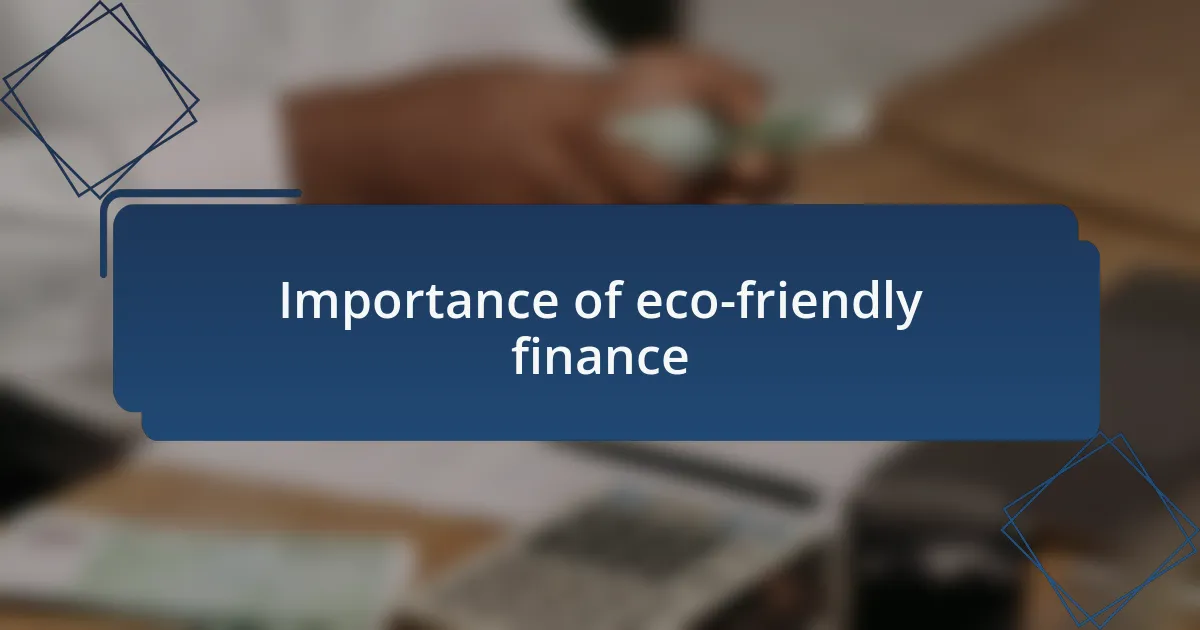
Importance of eco-friendly finance
Understanding the importance of eco-friendly finance goes beyond just numbers; it’s about creating a future that we can all be proud of. When I made the shift toward sustainable investments, I realized that I wasn’t just securing my financial future but actively contributing to a healthier planet. Every dollar I invested became a vote for the kind of world I wanted to live in.
Many people are unaware that eco-friendly finance is also a response to rising consumer demand for corporate accountability. I remember feeling skeptical when I first heard about companies changing their practices due to consumer pressure. However, it soon became clear that aligning investments with ethical practices could prompt companies to be more socially and environmentally responsible. Isn’t it remarkable how our choices can influence corporate behavior?
Moreover, embracing eco-friendly finance often leads to better long-term returns. One time, I hesitated to invest in a start-up that focused on renewable energy because of its perceived risk. But when I looked into the growth trends in that sector, I realized that the potential rewards could outweigh the risks. It taught me that sustainability and profitability can go hand in hand, reinforcing my belief that eco-friendly finance is essential not just for ethical reasons, but for smart investing as well.
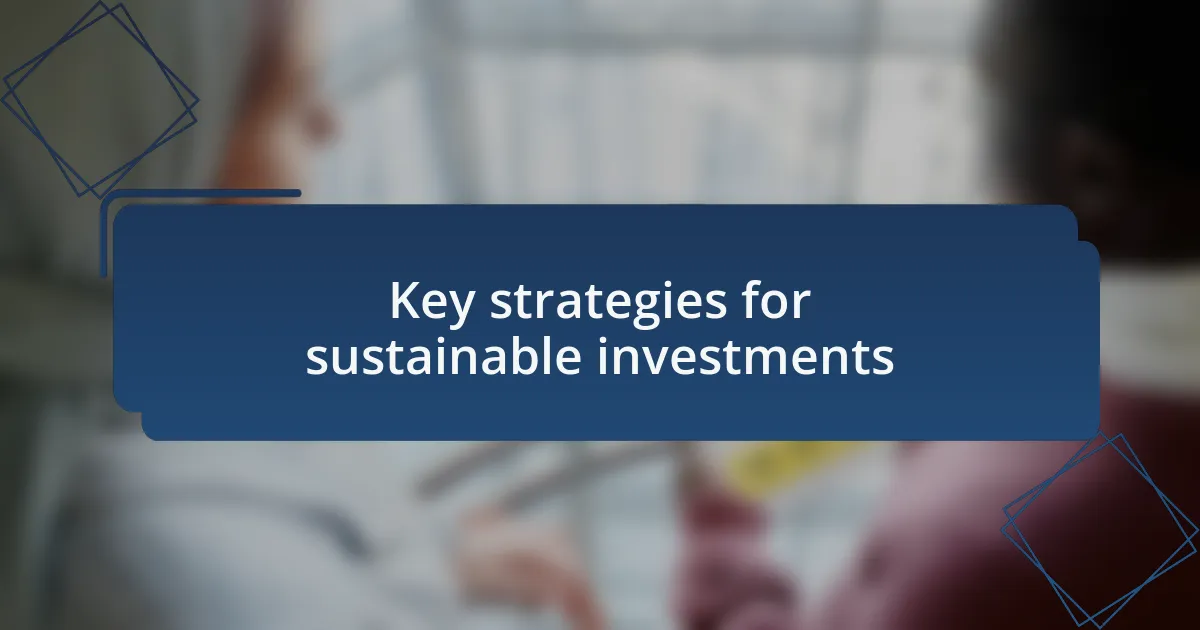
Key strategies for sustainable investments
When it comes to sustainable investments, diversifying your portfolio is one of the most effective strategies I’ve embraced. I remember my early days of investing when I felt compelled to stick to traditional sectors. However, branching out into green technologies, sustainable agriculture, and even eco-friendly bonds not only expanded my options but also mitigated risk. It’s fascinating how a well-rounded investment approach can open doors to remarkable opportunities while supporting the planet.
Another strategy that has served me well is conducting thorough research on companies’ environmental, social, and governance (ESG) practices. Initially, I would often overlook these details, focusing solely on potential returns. After a few uncomfortable experiences with companies that claimed to be sustainable but didn’t follow through, I learned the importance of scrutinizing their actual practices. I take a moment to ask myself: Are these companies genuinely committed to sustainability or simply jumping on the bandwagon? This approach has not only safeguarded my investments but has also reinforced my commitment to impactful investing.
Finally, I’ve found that engaging with my investments is crucial. Attending shareholder meetings or interacting on corporate sustainability initiatives has transformed the way I perceive my role as an investor. I once felt like an outsider in the financial world, but connecting with like-minded individuals who are equally passionate about sustainable development made me realize the power of community. Have you ever felt that sense of belonging? I certainly have, and it’s reassuring to know that together we can drive real change in the industries we invest in.
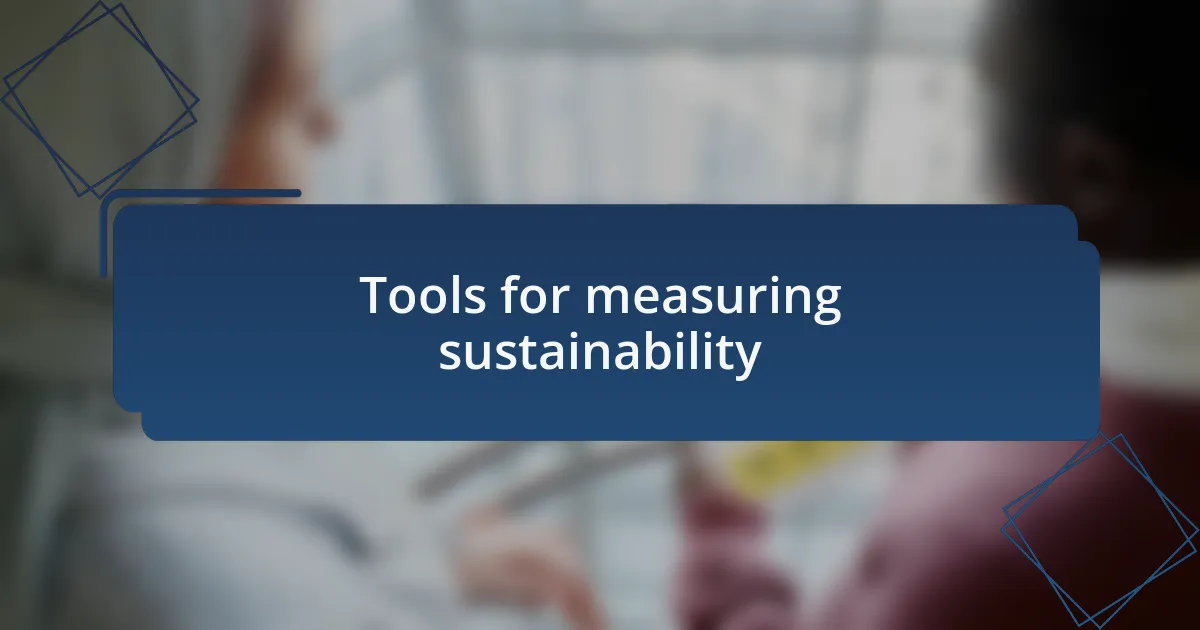
Tools for measuring sustainability
Tools for measuring sustainability are essential for making informed investment decisions. For instance, I often use screeners like MSCI ESG Ratings and Sustainalytics to evaluate a company’s sustainability performance. When I first started, I remember feeling overwhelmed by the plethora of data, but these tools helped me distill vast amounts of information into actionable insights. Have you ever wished for a way to make sense of complex performance metrics? These platforms simplify that process significantly.
Another critical resource I’ve found invaluable is green certification databases. I specifically look for certifications like LEED (Leadership in Energy and Environmental Design) or B Corp status. When I stumbled upon a local construction company with a LEED certification, it felt rewarding to know my investment would contribute to sustainable building practices. It’s heartening to support businesses that adhere to high environmental standards, and these certifications provide a reliable benchmark.
Lastly, I recommend using impact measurement tools that quantify the social and environmental effects of your investments. For example, I interact with platforms like EcoAct, which help investors understand their carbon footprints and impacts. Early on, I often felt disconnected from the consequences of my financial decisions, but by using these tools, I’ve developed a deeper awareness of how my investments contribute positively to the planet. Isn’t it empowering to realize that your financial choices can help drive progress towards a more sustainable future?
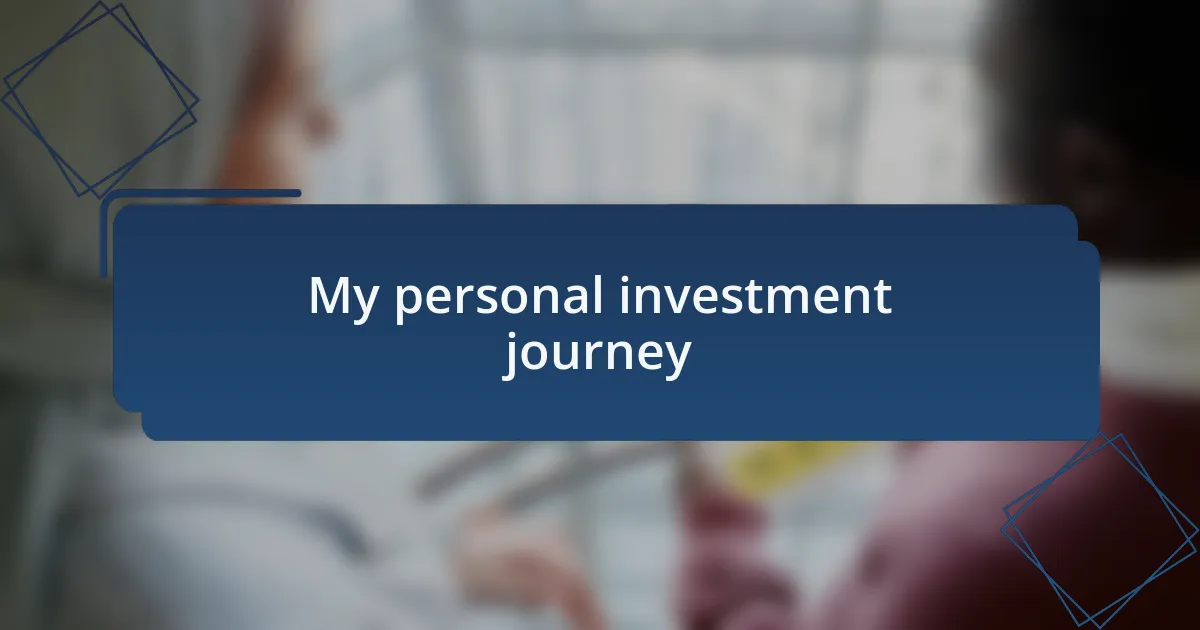
My personal investment journey
Investing sustainably has been a journey of discovery for me. I remember the first time I allocated funds into what I thought was a “green” company, only to later find that their practices didn’t align with my values. This experience taught me the importance of thorough research and genuine commitment to sustainability. Have you ever felt that sting when you realize your investment doesn’t stand for what you believed it would?
As I navigated my path, I often reflected on the values I want my financial choices to represent. A memory that stands out is when I attended a sustainable investing seminar and heard a passionate speaker share their journey. It was inspiring to see how they connected their investments to their life goals. That experience pushed me to align my portfolio with companies that genuinely prioritize environmental stewardship and social responsibility. It’s like piecing together a puzzle, where each investment contributes to a bigger picture that resonates with my personal ethos.
Over the years, I’ve learned that sustainable investing isn’t just about financial returns; it affects my sense of fulfillment too. I recall when I invested in a renewable energy startup—seeing the positive impact of my investment in real-time was exhilarating. Every quarterly update became an opportunity to celebrate progress not just for my wallet, but for the planet. Isn’t it rewarding to know that our money can help foster innovation and sustainability?
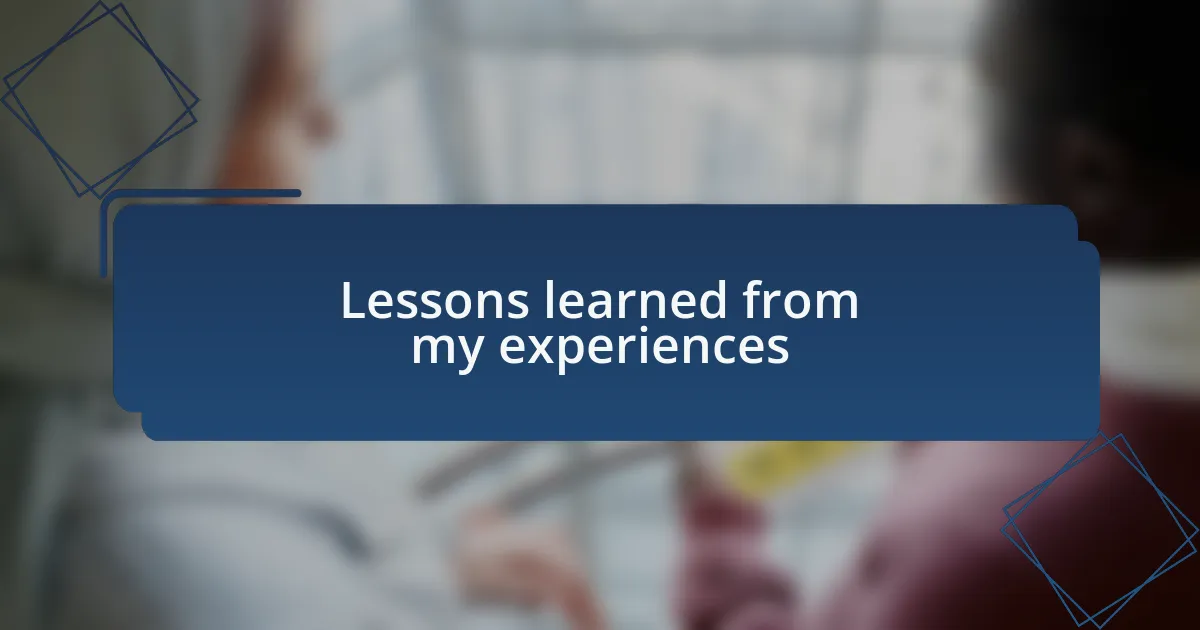
Lessons learned from my experiences
One of the most important lessons I’ve learned is the significance of aligning investments with my long-term values. For instance, I once invested in a socially responsible fund, only to later discover that a large portion of its holdings included companies involved in fossil fuels. This misalignment was disheartening, but it pushed me to refine my investment criteria and prioritize transparency. Have you ever felt that disconnect, realizing your choices didn’t reflect your core beliefs?
I’ve also found that patience is crucial in sustainable investing. Early on, I was eager for quick returns and made hasty decisions. However, witnessing the gradual success of a sustainable agriculture venture taught me the value of allowing time for growth. It reminded me that building a sustainable future requires nurturing, much like tending to a garden. Isn’t it fascinating how the journey can sometimes be just as important as the destination?
Lastly, I’ve discovered the power of community. Joining an investment group focused on sustainability connected me with like-minded individuals who shared their experiences and insights. One memorable conversation about the challenges of ethical investing still resonates with me; it reinforced the idea that I’m not alone on this path. Together, we can support each other and make a collective impact. Have you considered the strength that comes from being part of a supportive network?
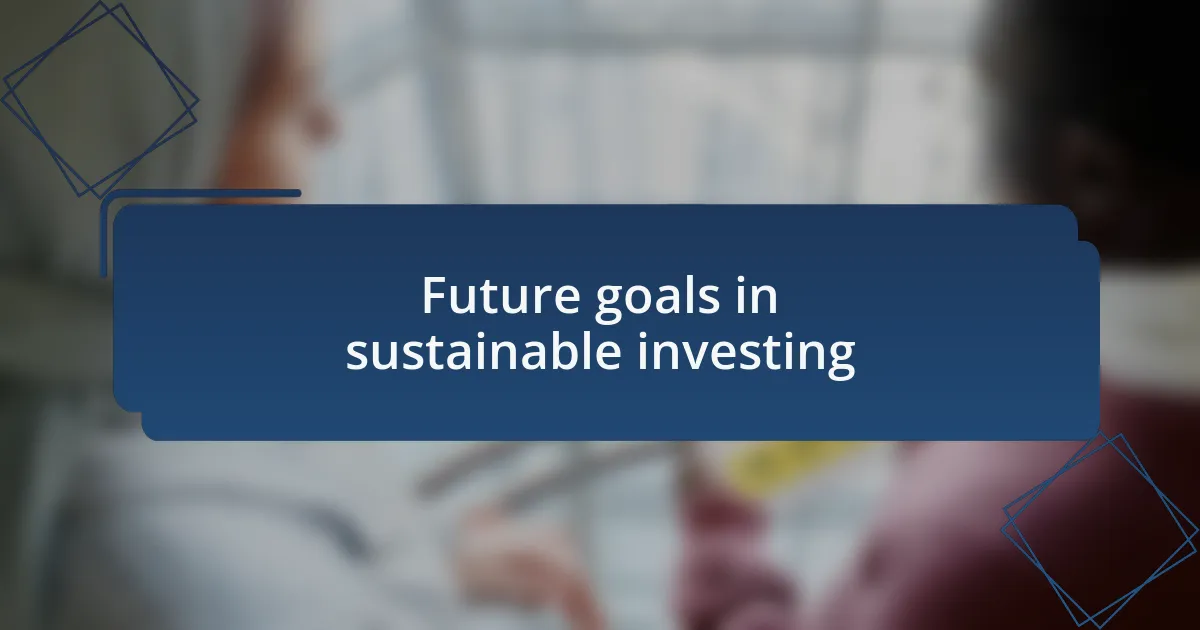
Future goals in sustainable investing
As I look toward the future of sustainable investing, I realize how vital it is to set clear, actionable goals. One of my aspirations is to actively seek out investments in renewable energy companies that prioritize innovation and sustainability. I’ve often asked myself, how can I leverage my resources to not just see financial returns, but to also contribute to a healthier planet? Each new investment feels like stepping into a story of potential, and I want to ensure I’m writing a narrative that aligns with a sustainable future.
In my journey, I’ve become increasingly aware of the importance of engaging with companies on their sustainability commitments. Recently, I reached out to a tech firm I was considering investing in, and their earnest focus on reducing carbon emissions truly impressed me. Wouldn’t it be powerful if more investors demanded transparency and accountability from the companies we support? This experience ignited my desire to build relationships with the businesses I back, ensuring they walk the talk on sustainability.
I’ve also set a personal goal to diversify my portfolio with social impact bonds in mind. These investments support initiatives that benefit communities while yielding returns. I sometimes wonder about the ripple effects of my investment choices. What if my funds could help alleviate poverty or improve education in marginalized communities? That thought inspires me to push boundaries in my investing strategy, knowing that each decision can foster systemic change.